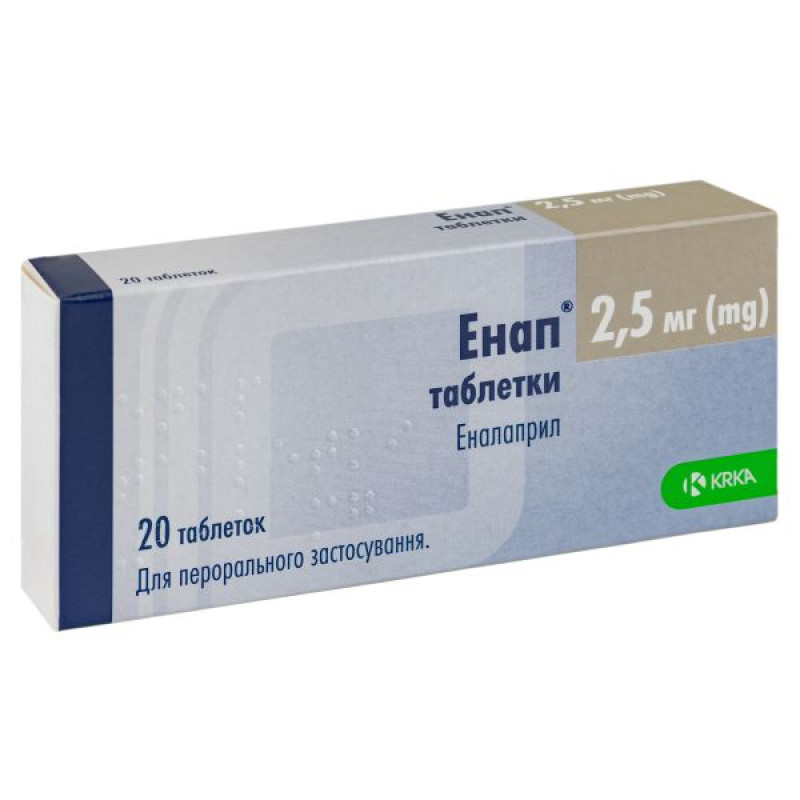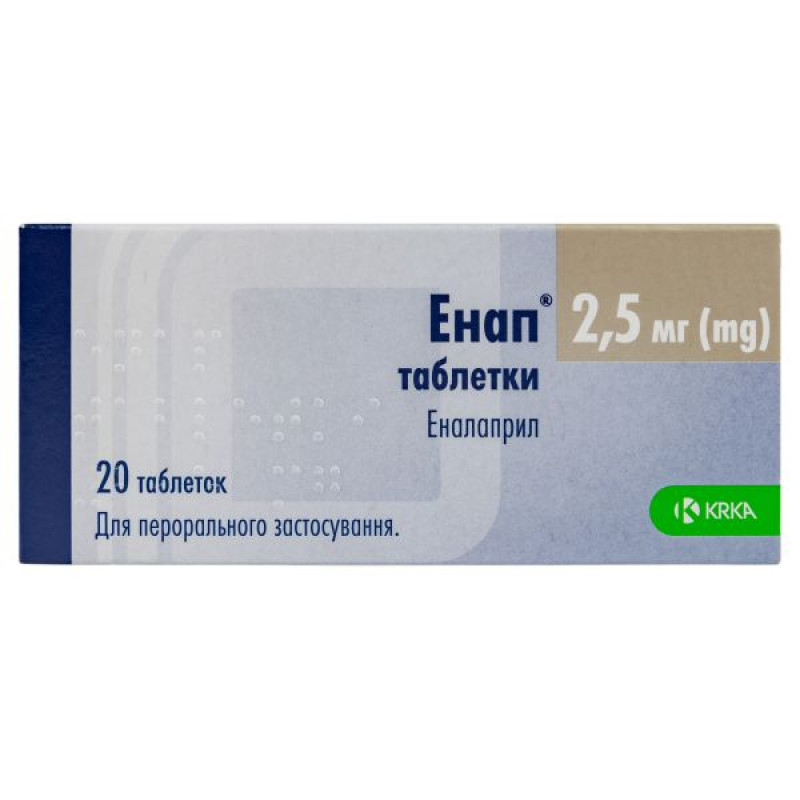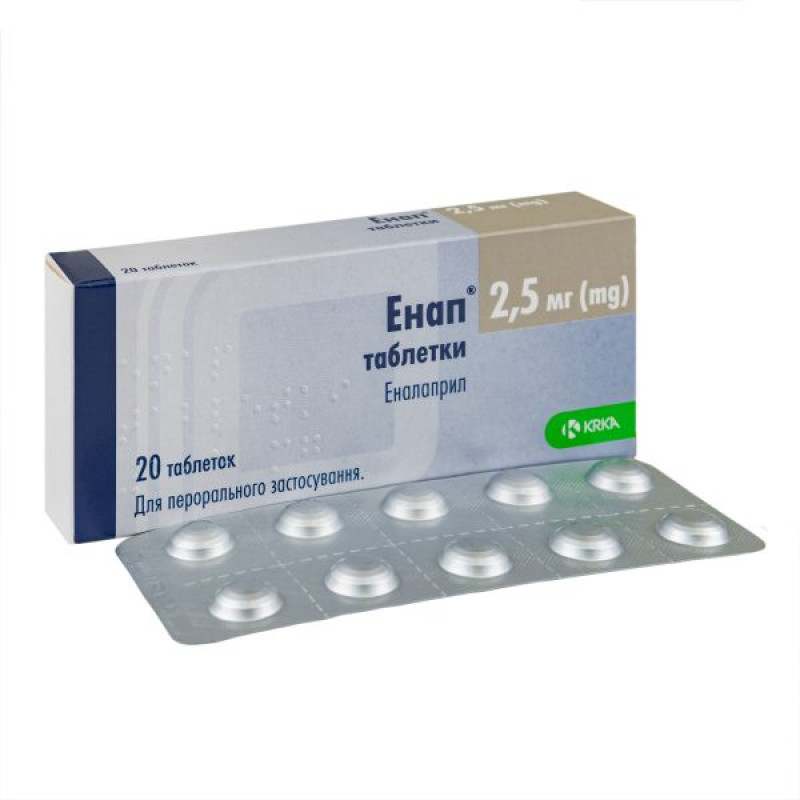Enap tablets 2.5 mg blister No. 20

Enap ® tablets are used for the following indications:
Treatment of arterial hypertension; Treatment of clinically significant heart failure; Prevention of clinically significant heart failure in patients with asymptomatic left ventricular dysfunction (ejection fraction ≤ 35%).Composition
The active substance is enalapril maleate (one tablet contains 2.5 mg of enalapril maleate).
Excipients: sodium bicarbonate, lactose monohydrate, corn starch, hydroxypropyl cellulose, talc, magnesium stearate.
Contraindication
Hypersensitivity to enalapril or any other component of the drug, or to other angiotensin-converting enzyme (ACE) inhibitors; history of angioedema associated with previous treatment with ACE inhibitors; hereditary or idiopathic angioedema; pregnant women or women planning to become pregnant; Enap ® should not be used with drugs containing aliskiren, diabetics or those with impaired renal function (GFR <60 ml / minute / 1.73 m 2).Method of application
Food intake does not affect the absorption of these tablets. The dosage should be selected individually according to the condition of each patient and the blood pressure response.
Arterial hypertension
The dose of the drug ranges from an initial dose of 2.5 mg to a maximum dose of 20 mg once a day, depending on the degree of arterial hypertension and the patient's condition. For mild arterial hypertension, the recommended initial dose is 5-10 mg.
In patients with a strongly activated angiotensin-aldosterone system (e.g. renovascular hypertension, salt and/or fluid imbalance, cardiac decompensation or severe hypertension), an excessive decrease in blood pressure may occur after the initial dose. In such patients, a starting dose of 5 mg or lower is recommended, and the patient should be under medical supervision at the beginning of treatment.
Previous therapy with high doses of diuretics may lead to fluid depletion and the risk of hypotension at the beginning of therapy with enalapril. For such patients, an initial dose of 5 mg or lower is recommended. If possible, diuretic therapy should be discontinued 2-3 days before starting treatment with Enap ®. For patients who cannot discontinue diuretics before starting therapy with Enap ®, the initial dose is 2.5 mg as a single dose. Renal function and serum potassium should be monitored.
The usual maintenance dose is 20 mg once daily. The maximum maintenance dose is 40 mg daily given as a single dose or in 2 divided doses.
Children with arterial hypertension aged 6 years and older
Experience with the clinical use of the drug "Enap ®" in children with arterial hypertension is limited.
For children who can swallow tablets, the dose should be individualized according to the patient's condition, blood pressure response to treatment, and body weight. The recommended initial dose is 2.5 mg once daily for patients weighing 20 to 50 kg and 5 mg once daily for patients weighing ≥ 50 kg. The dosage should be adjusted as needed to a maximum dose of 20 mg/day for patients weighing 20 to 50 kg and 40 mg/day for patients weighing ≥ 50 kg (0.58 mg/kg body weight).
The drug is not recommended for neonates and children with a glomerular filtration rate <30 ml/minute/1.73 m2 due to lack of data.
Heart failure/asymptomatic left ventricular dysfunction
For the treatment of clinically severe heart failure, enalapril should be used with diuretics and, if necessary, with digitalis or beta-blockers. The initial dose of Enap ® for patients with clinically severe heart failure or asymptomatic left ventricular dysfunction is 2.5 mg, while the use of the drug should be carried out under the supervision of a physician in order to establish the initial effect of the drug on blood pressure. In the absence of effect or after appropriate correction of symptomatic hypotension that occurred at the beginning of treatment for heart failure with enalapril, the dose should be gradually increased to the usual maintenance dose of 20 mg, taken once or divided into 2 doses, depending on what is better tolerated by the patient. Dose selection is recommended to be carried out within 2-4 weeks. Such a therapeutic regimen effectively reduces mortality rates in patients with clinically severe heart failure. The maximum dose is 40 mg per day in 2 doses.
Both before and after the start of treatment with enalapril, blood pressure and renal function should be carefully monitored, since hypotension and (less frequently) subsequent renal failure have been reported. Patients taking diuretics should have their dose reduced if possible before starting treatment with Enap ®. The development of hypotension after the initial dose of enalapril does not mean that hypotension will persist with continued treatment and does not indicate the need to discontinue the drug. Serum potassium and renal function should also be monitored.
Application features
Pregnant women
ACE inhibitors are contraindicated in pregnant women and women planning to become pregnant. Limited pharmacokinetic data indicate that very low concentrations of the drug are present in breast milk. Although these concentrations are considered clinically relevant, the use of this drug is not recommended during breastfeeding in premature infants and in the first few weeks after birth because of the hypothetical risk of cardiovascular and renal effects and because of the lack of experience. In older infants, use during breastfeeding may be considered if treatment is necessary for the mother and the infant is observed for any adverse effects.
Drivers
When driving or operating other machinery, the possible development of dizziness or increased fatigue should be taken into account.
Overdose
There are limited data on overdose in humans. The main signs of overdose, according to the available data, are pronounced arterial hypotension, which begins approximately 6 hours after taking the drug and coincides with the blockade of the renin-angiotensin system, and stupor. Symptoms associated with overdose with ACE inhibitors may include circulatory shock, electrolyte imbalance, renal failure, hyperventilation of the lungs, tachycardia, palpitations, bradycardia, dizziness, anxiety and cough. Plasma levels of enalaprilat, which exceed 100 and 200 times the maximum levels achieved with therapeutic doses, have been reported after taking 300 mg and 440 mg of enalapril, respectively.
For the treatment of overdose, intravenous infusions of isotonic solution are recommended. If hypotension occurs, the patient should be placed in a horizontal position. The need for infusions of angiotensin II and / or intravenous administration of catecholamines may be considered. If the drug has been taken recently, measures to eliminate enalapril maleate (such as artificial vomiting, gastric lavage, administration of absorbents and sodium sulfate) are recommended. Enalaprilat can be removed from the systemic circulation by hemodialysis. Pacemaker therapy is indicated for bradycardia that is resistant to therapeutic agents. Vital signs, electrolyte concentrations and serum creatinine levels should be monitored continuously.
Side effects
From the blood and lymphatic system: anemia, neutropenia, decreased hemoglobin, decreased hematocrit, thrombocytopenia, agranulocytosis, bone marrow depression, pancytopenia, lymphadenopathy, autoimmune diseases.
On the part of the endocrine system: syndrome of inappropriate antidiuretic hormone secretion.
Metabolism and digestion: hypoglycemia in patients with diabetes taking oral hypoglycemic agents or insulin.
From the nervous system and psyche: headache, depression, confusion, drowsiness, insomnia, nervousness, paresthesias, vertigo, abnormal dreams, sleep disorders.
From the organs of vision: blurred vision.
Cardiovascular system: dizziness, hypotension, syncope, chest pain, cardiac arrhythmias, angina pectoris, tachycardia, orthostatic hypotension, palpitations, myocardial infarction or cerebrovascular stroke, possibly secondary to excessive hypotension in high-risk patients, Raynaud's phenomenon.
Respiratory, thoracic and mediastinal disorders: cough, dyspnoea, rhinorrhea, sore throat and hoarseness, pharyngitis, bronchospasm/asthma, pulmonary infiltrates, rhinitis, allergic alveolitis/eosinophilic pneumonia.
Gastrointestinal: nausea, diarrhea, abdominal pain, taste perversion, intestinal obstruction, pancreatitis, vomiting, dyspepsia, constipation, anorexia, gastric irritation, dry mouth, peptic ulcers, stomatitis/aphthous ulcers, glossitis, angioedema of the gastrointestinal tract with simultaneous use of ACE inhibitors, including enalapril.
From the liver and biliary tract: hepatic failure, hepatitis - hepatocellular or cholestatic, hepatonecrosis, cholestasis, including jaundice.
Skin and subcutaneous tissue disorders: rash, hypersensitivity/angioedema; angioedema of the face, extremities, lips, tongue, glottis and/or larynx, sweating, itching, urticaria, alopecia, facial flushing, erythema multiforme, Stevens-Johnson syndrome, exfoliative dermatitis, toxic dermal necrolysis, pemphigus, erythroderma.
Renal and urinary disorders: renal dysfunction, renal failure, proteinuria, oliguria.
From the reproductive system and mammary glands: impotence, gynecomastia.
Store in the original packaging (to protect from moisture) at a temperature not exceeding 25 °C, out of the reach of children.
Shelf life - 3 years.
There are no reviews for this product.
There are no reviews for this product, be the first to leave your review.
No questions about this product, be the first and ask your question.





